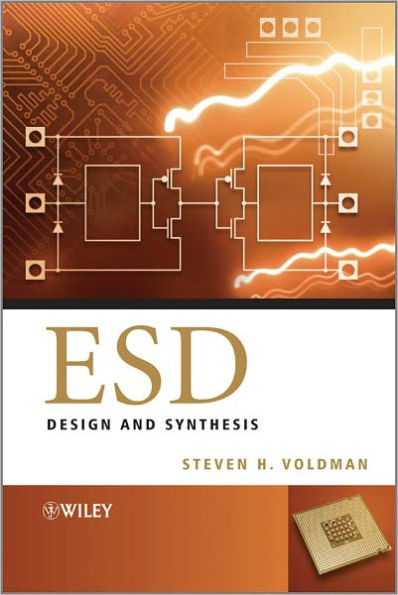ESD: Design and Synthesis / Edition 1 available in Hardcover, eBook

ESD: Design and Synthesis / Edition 1
- ISBN-10:
- 0470685719
- ISBN-13:
- 9780470685716
- Pub. Date:
- 04/25/2011
- Publisher:
- Wiley

ESD: Design and Synthesis / Edition 1
Buy New
$135.95Overview
This book studies electrical overstress, ESD, and latchup from a whole-chip ESD design synthesis approach. It provides a clear insight into the integration of ESD protection networks from a generalist perspective, followed by examples in specific technologies, circuits, and chips. Uniquely both the semiconductor chip integration issues and floorplanning of ESD networks are covered from a ‘top-down' design approach.
Look inside for extensive coverage on:
- integration of cores, power bussing, and signal pins in DRAM, SRAM, CMOS image processing chips, microprocessors, analog products, RF components and how the integration influences ESD design and integration
- architecturing of mixed voltage, mixed signal, to RF design for ESD analysis
- floorplanning for peripheral and core I/O designs, and the implications on ESD and latchup
- guard ring integration for both a ‘bottom-up' and ‘top-down' methodology addressing I/O guard rings, ESD guard rings, I/O to I/O, and I/O to core
- classification of ESD power clamps and ESD signal pin circuitry, and how to make the correct choice for a given semiconductor chip
- examples of ESD design for the state-of-the-art technologies discussed, including CMOS, BiCMOS, silicon on insulator (SOI), bipolar technology, high voltage CMOS (HVCMOS), RF CMOS, and smart power
- practical methods for the understanding of ESD circuit power distribution, ground rule development, internal bus distribution, current path analysis, quality metrics
ESD: Design and Synthesis is a continuation of the author's series of books on ESD protection. It is an essential reference for: ESD, circuit, and semiconductor engineers; design synthesis team leaders; layout design, characterisation, floorplanning, test and reliability engineers; technicians; and groundrule and test site developers in the manufacturing and design of semiconductor chips.
It is also useful for graduate and undergraduate students in electrical engineering, semiconductor sciences, and manufacturing sciences, and on courses involving the design of ESD devices, chips and systems. This book offers a useful insight into the issues that confront modern technology as we enter the nano-electronic era.

Product Details
| ISBN-13: | 9780470685716 |
|---|---|
| Publisher: | Wiley |
| Publication date: | 04/25/2011 |
| Pages: | 290 |
| Product dimensions: | 6.80(w) x 9.90(h) x 0.90(d) |
About the Author
Read an Excerpt
Table of Contents
About the Author.Preface.
Acknowledgements.
1 ESD Design Synthesis.
1.1 ESD Design Synthesis and Architecture Flow.
1.2 ESD Design - The Signal Path and the Alternate Current Path.
1.3 ESD Electrical Circuit and Schematic Architecture Concepts.
1.4 Mapping Semiconductor Chips and ESD Design.
1.5 ESD Chip Architecture and ESD Test Standards.
1.6 ESD Testing.
1.7 ESD Chip Architecture and ESD Alternative Current Path.
1.8 ESD Networks, Sequencing and Chip Architecture.
1.9 ESD Design Synthesis - Latchup-Free ESD Networks.
1.10 ESD Design Concepts - Buffering - Inter-Device.
1.11 ESD Design Concepts - Ballasting - Inter-Device.
1.12 ESD Design Concepts - Ballasting - Intra-Device.
1.13 ESD Design Concepts - Distributed Load Techniques.
1.14 ESD Design Concepts - Dummy Circuits.
1.15 ESD Design Concepts - Power Supply De-coupling.
1.16 ESD Design Concepts - Feedback Loop De-Coupling.
1.17 ESD Layout and Floorplan-Related Concepts.
1.18 ESD Design Concepts - Analog Circuit Techniques.
1.19 ESD Design Concepts - Wire Bonds.
1.20 Design Rules.
1.21 Summary and Closing Comments.
Problems.
References. 2 ESD Architecture and Floorplanning.
2.1 ESD Design Floorplan.
2.2 Peripheral I/O Design.
2.3 Lumped ESD Power Clamp in Peripheral I/O Design Architecture.
2.4 Lumped ESD Power Clamp in Peripheral I/O Design Architecture Master/Slave ESD Power Clamp System.
2.5 Array I/O.
2.6 ESD Architecture - Dummy Bus Architecture.
2.7 Native Voltage Power Supply Architecture.
2.8 Mixed-Voltage Architecture.
2.9 Mixed-Signal Architecture.
2.10 Mixed-System Architecture - Digital and Analog CMOS.
2.11 Mixed-Signal Architecture - Digital, Analog, and RF Architecture.
2.12 Summary and Closing Comments.
Problems.
References.
3 ESD Power Grid Design.
3.1 ESD Power Grid.
3.2 Semiconductor Chip Impedance.
3.3 Interconnect Failure and Dynamic On-Resistance.
3.4 Interconnect Wire and Via Guidelines.
3.5 ESD Power Grid Resistance.
3.6 Power Grid Layout Design.
3.7 ESD Specification Power Grid Considerations.
3.8 Power Grid Design Synthesis - ESD Design Rule Checking Methods.
3.9 Summary and Closing Comments.
Problems.
References.
4 ESD Power Clamp.
4.1 ESD Power Clamps.
4.2 Design Synthesis of ESD Power Clamps.
4.3 Design Synthesis of ESD Power Clamps - The ESD Power Clamp Shunting Element.
4.4 ESD Power Clamp Issues.
4.5 ESD Power Clamp Design.
4.6 ESD Power Clamp Design Synthesis - Bipolar ESD Power Clamps.
4.7 Master/Slave ESD Power Clamp Systems.
4.8 Summary and Closing Comments.
Problems.
References.
5 ESD Signal Pin Network Design and Synthesis.
5.1 ESD Signal Pin Structures.
5.2 ESD Signal Input Structures - ESD and Bond Pads Layout.
5.3 ESD Design Synthesis and Layout of MOSFETs.
5.4 ESD Design Synthesis and Layout of Diodes.
5.5 ESD Design Synthesis of SCRs.
5.6 ESD Design Synthesis and Layout of Resistors.
5.7 ESD Design Synthesis of Inductors.
5.8 Summary and Closing Comments.
Problems.
References.
6 Guard Ring Design and Synthesis.
6.1 Guard Ring Design and Integration.
6.2 Guard Ring Characterization.
6.3 Semiconductor Chip Guard Ring Seal.
6.4 I/O to Core Guard Rings.
6.5 I/O to I/O Guard Rings.
6.6 Within I/O Guard Rings.
6.7 ESD Signal Pin Guard Rings.
6.8 Library Element Guard Rings.
6.9 Mixed-Signal Guard Rings - Digital to Analog.
6.10 Mixed-Voltage Guard Rings - High Voltage to Low Voltage.
6.11 Passive and Active Guard Rings.
6.12 Trench Guard Rings.
6.13 TSV Guard Rings
6.14 Guard Ring DRC.
6.15 Guard Ring and Computer Aided Design Methods.
6.16 Summary and Closing Comments.
Problems.
References.
7 ESD Full-Chip Design Integration and Architecture.
7.1 Design Synthesis and Integration.
7.2 Digital Design.
7.3 Custom Design vs. Standard Cell Design.
7.4 Memory ESD Design.
7.5 Microprocessor ESD Design.
7.6 Application-Specific Integrated Circuits.
7.7 CMOS Image Processing Chip Design.
7.8 Mixed-Signal Architecture.
7.9 Summary and Closing Comments.
Problems.
References.
Index.
